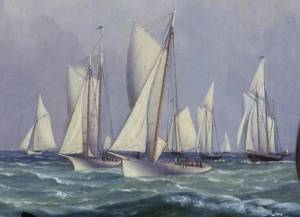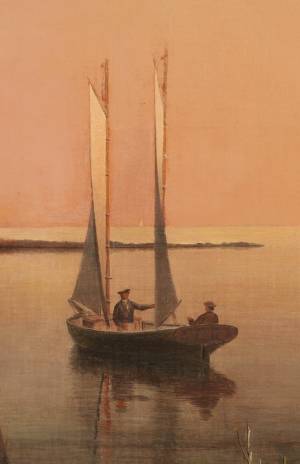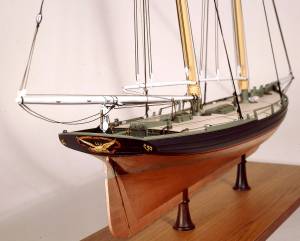An online project under the direction of the CAPE ANN MUSEUM
inv. 188
Sloop with Study of Masthead Rigging
1850s Graphite on paper 1 sheet of paper 10 3/4 x 14 1/4 in. (27.3 x 36.2 cm) Signed lower right (in pencil): Lane del.
|
Explore catalog entries by keywords view all keywords »
Historical Materials
Below is historical information related to the Lane work above. To see complete information on a subject on the Historical Materials page, click on the subject name (in bold and underlined).
Yachting in New York Harbor had its beginnings in the early nineteenth century, largely through the efforts of John Stevens who, as a young man, built boats of his own designs with highly varied hull forms and rigs. By the early 1830s, he had others designing and building yachts to his specifications, including three notable schooners: “Wave”, “Onkahye”, and in 1844, the schooner “Gimcrack”. (Ref. 1)
It was on board “Gimcrack” that the New York Yacht Club was formally organized on July 30, 1844. The following week, the club held its first cruise – to Newport, Rhode Island. Thereafter, cruises were a regular event, with annual regattas held in New York waters or nearby ports. Newport became the most popular and enduring (to this day) vacation port for members on their summer cruises. (Ref. 2)
Perhaps the club’s most lasting mark on the world of yachting was the building of the schooner yacht “America” under the sponsorship of its members. In winning the “100 Guinea Cup”, this vessel caught the attention and respect of yacht builders and naval architects everywhere. The trophy was soon called “The America’s Cup” and became the most prestigious prize in international yachting – successfully defended by American yachts for over a century. (Ref. 3)
“America” caught Lane’s attention too. The first time was in New York late in 1850, when he saw her under construction. George Steers probably granted him access to the half model and sail plan, and from that he depicted her under sail in three views (on the same canvas). After her victory at Cowes and the publication of Dutton’s lithograph, Lane painted a copy of that image The Yacht "America" Winning the International Race, 1851 (inv. 255) with some alterations to the deck arrangement. (Ref. 4)
Growth of the club fleet was evident at its regatta at New Bedford in 1856, when eight sloops and five schooners participated to the delight of a large local audience. Lane’s depictions of the event and the vessels New York Yacht Club Regatta (1), 1856 (inv. 66) and New York Yacht Club Regatta (2), 1856 (inv. 270), coupled with Robert Bennet Forbes’s newspaper account, offer what is possibly the most complete extant visual and verbal description of an early American yacht club regatta. (Ref. 5)
New York Yacht Club’s growth was just beginning. From nine vessels in 1844, the fleet grew to eight sloops and five schooners at the New Bedford regatta. By 1860, their numbers grew to 24 sloops and 21 schooners, and by 1868 there were 13 sloops and 28 schooners. (Ref. 6)
– Erik Ronnberg
References:
1. William P. Stephens, “Traditions & Memories of American Yachting” (Camden, Maine:International Marine Publishing Co., 1981), pp. 5, 7.
2. Ibid., p. 7.
3. Ibid., pp. 8 – 10.
4. Erik A. R. Ronnberg, Jr., “Fitz Henry Lane”s ‘Yacht America’ from Three Views’: Vessel Portrait or Artist’s Concept” Antiques and Fine Art. (Summer/Autumn, 2010), pp. 174-179.
5. Robert Bennet Forbes, “Regatta at New Bedford, Massachusetts, 8 August, 1856” (Document contributed by Llewellyn Howland in The American Neptune, Vol. X, 1950), pp. 231-234.
6. Stephens, “Traditions & Memories of American Yachting”, pp. 7, 28.
The U.S. Nautical Magazine and Naval Journal, vol. 4, no. 1
pp. 464–65.
Contains brief announcement of the line-up of the August 8, 1856 race depicted by Lane.
Also filed under: "Julia" (Sloop Yacht) » // "Widgeon" (Sloop Yacht) » // Newspaper / Journal Articles » // Publications » // Regattas »
The U.S. Nautical Magazine and Naval Journal, vol. 5
pp. 16–18
Article about the New-York Yacht Club regatta held at New Bedford on August 8, 1856, as painted by Lane. Includes lists of participating yachts and times in New Bedford.
unidentified newspaper clipping
16 October 1846
Robert Bennet Forbes Scrapbook
volume 1, p.55
Phillips Library, Peabody Essex Museum (SCR 4)
Also filed under: "Northern Light" (Yacht) » // Regattas »
New Bedford is a coastal town in Massachusetts, and in the nineteenth century was one of the most important whaling ports in America. New Bedford Harbor (with New Bedford on one side and the town of Fairhaven on the other) is the estuary of the Acushnet River. The river empties into Buzzards Bay past Clarks Point, the southernmost point of the city. In 1856 the New-York Yacht Club Regatta took place in New Bedford, and Lane made several paintings of the event.
New Bedford and Old Dartmouth: A Portrait of a Region's Past, New Bedford: Old Dartmouth Historical Society, 1976.
The U.S. Nautical Magazine and Naval Journal, vol. 5
pp. 16–18
Article about the New-York Yacht Club regatta held at New Bedford on August 8, 1856, as painted by Lane. Includes lists of participating yachts and times in New Bedford.
The New York Yacht Club’s regatta was held in New Bedford, Massachusetts in 1856. The winner in the first class (largest yachts) was the “Julia”, owned by J. M. Waterbury, who commissioned George Steers to design and build her in 1854. Waterbury was a founding member of the New York Yacht Club, who had commissioned Steers to design and build the racing sloop “Una” for him in 1847.(Ref. 1)
Throughout the race, “Julia” led the other yachts in her class and led all other yachts in the regatta at the finish line. She is almost certainly the sloop in the left foreground of New York Yacht Club Regatta (1), 1856 (inv. 66), and while nearly identical to the sloop in the center foreground of Camden Mountains from the South Entrance to Harbor (inv. 290), the two fly very different owner’s pennants, probably the only way sloops of this design can be told apart in this series of paintings. (Ref. 2)
–Erik Ronnberg
References:
1. William P. Stephens, “Traditions & Memories of American Yachting” (Camden, Maine: International Marine Publishing Company, 1981), pp. 44, 272, 274.
2. “The U. S. Nautical Magazine, and Naval Journal” (New York: Oliver W. Griffiths, 1856). Vol. V, October, 1856 to March, 1857, pp. 15-17.
The U.S. Nautical Magazine and Naval Journal, vol. 4, no. 1
pp. 464–65.
Contains brief announcement of the line-up of the August 8, 1856 race depicted by Lane.
Also filed under: "Widgeon" (Sloop Yacht) » // New-York Yacht Club » // Newspaper / Journal Articles » // Publications » // Regattas »
The U.S. Nautical Magazine and Naval Journal, vol. 5
pp. 16–18
Article about the New-York Yacht Club regatta held at New Bedford on August 8, 1856, as painted by Lane. Includes lists of participating yachts and times in New Bedford.
Yachts and yachting in ninteenth-century America were the preserve of the wealthy, and in Lane's early career were just beginning to organize as yacht clubs with scheduled regattas. The New York Yacht Club, founded in 1844, was the first such organization and had few rival clubs for racing or cruising until after the Civil War. (1) In Boston, by contrast, yachts of any size were few. Instead of regattas, competition was in the form of match races, between two vessels, with cash prizes as a substitute for trophies. Often, the only serious competition for a Boston-owned yacht was one of the crack pilot schooners, and it was not uncommon for a yacht to be sold for pilot service or vice-versa. (2)
If Lane had opportunity to portray any yachts in Boston, only his depiction of schooner "Northern Light" (see The Yacht "Northern Light" in Boston Harbor, 1845 (inv. 268)) has been found to date, and that was based on a drawing by Robert Salmon. (3) It seems likely that he would have depicted more Boston yachts, some of which images might still exist in private collections not currently accessible. For more depictions of yachts by Lane, we must look to New York.
Lane is known to have made two paintings of the schooner yacht "America." The more familiar one The Yacht "America" Winning the International Race, 1851 (inv. 255) was based on a lithograph derived from a painting by Oswald Brierly who witnessed and sketched "America" as she raced for the trophy that now bears her name. (4)
The other painting Yacht "America" from Three Views, c.1851 (inv. 395) was very possibly based on sketches of the designer's half-model, or even the actual vessel under construction. In either case, Lane's drawings and any notes would have been made before the hull and deck details were finalized. (5)
It would not be until August 8, 1856 that Lane would see and sketch a major yacht regatta—held by the New York Yacht Club at New Bedford, Massachusetts. From this event, he painted four known views, each depicting a different moment in the race. The earliest New York Yacht Club Regatta (3), After 1856 (inv. 396) shows the yachts under way to the starting line, with the smallest yachts (third class) starting at 10:50 a.m. The second class would start at 10:55 a.m. and the first (largest yachts) at 11:00 a.m. The second view New York Yacht Club Regatta (2), 1856 (inv. 270) shows the start of the first class; the third New York Yacht Club Regatta (4), 1857 (inv. 397), the race after the start with the large sloops and schooners taking the lead. The fourth New York Yacht Club Regatta (1), 1856 (inv. 66), depicting the finish, shows the winning sloop "Julia" over the line, lowering her racing sails, while the rest of the fleet follows her to the finish line. (6 and 7)
As interest in yachting increased, so did leisure pursuits in smaller craft, using rowing and sailing boats for rowing, fishing, and day-sailing. These activities had a commercial side which is covered in the Party Boats descriptive essay, but this essay will deal with boats used for non-commercial recreation.
Hull types and rigs for small pleasure craft were varied, some being traditional work boat designs with a few added amenities for comfort. Others were designed and built for leisure boating, often in the styles of yachts, but smaller and simpler. Among rowing boats, the dory was a logical choice, the version in View of Gloucester, (From Rocky Neck), 1846 (inv. 57) (right foreground) being smaller, with a wider bottom for greater stability. New England boats (see Norman's Woe, Gloucester Harbor, 1862 (inv. 1), View of Gloucester, 1859 (inv. 91), and Castine Harbor and Town, 1851 (inv. 272)) are also to be found in settings more akin to leisure than to work. (8)
Sailing craft custom-built for pleasure were also depicted by Lane. Examples with sloop rigs are found in The Old Fort and Ten Pound Island, Gloucester, 1850s (inv. 30) (left foreground), Fresh Water Cove from Dolliver's Neck, Gloucester, Early 1850s (inv. 45) (center left), and Coming Ashore near Brace's Rock, Gloucester, Massachusetts, c.1860 (inv. 60) (right foreground). The yawl rig is seen in View of Coffin's Beach, 1862 (inv. 41) (right middle ground), and schooners in Fresh Water Cove from Dolliver's Neck, Gloucester, Early 1850s (inv. 45) (right middle ground) and View of Gloucester, Mass., 1859 (not published) (foreground). These rigs differ only moderately from today's versions; their hull designs remain popular among admirers and owners of "traditional boats."
– Erik Ronnberg
References:
1. William P. Stephens, Traditions and Memories of American Yachting (Camden, ME: International Marine Publishing Co., 1981), 157–59.
2. Ibid., 159–61, 164–66.
3. John Wilmerding, Fitz Hugh Lane, 1804–1865: American Marine Painter (Salem, MA: Essex Institute,1964), 29–30.
4. Erik A.R. Ronnberg, Jr., "Fitz Henry Lane's Yacht America from Three Views: Vessel Portrait or Artist's Concept?," Antiques & Fine Art (Summer/Autumn 2010): 175.
5. Ibid., 174–79.
6. U.S. Nautical Magazine and Naval Journal V (October 1956–March 1857): 16–18.
7. The American Neptune X, no. 3 (July 1950): 231–34. Reprint of an unidentified newspaper account of the 1856 New Bedford Regatta by Robert Bennet Forbes.
8. See the descriptive essay on "New England Boat."
See p. 163.
Also filed under: "Northern Light" (Yacht) »
Parker & Ditson
Courtesy American Antiquarian Society, Worcester, Mass.
Dedicated to the Tiger Boat Club.
Also filed under: Bufford, J. H. Lith. – Boston » // Parker & Ditson, Pub. – Boston » // Sheet Music by other artists » // Thayer's, Lith. – Boston » // Tiger Boat Club »
The Rudder Vol. XV Part 1–3; pp. 387–390, 456–460, 483–486
"Historic American Yachts: Early Boston Vessels, The Northern Light and Coquette."
Also filed under: "Northern Light" (Yacht) »
wood, metal, cordage
Model of schooner yacht "Northern Light" of Boston, 1839
Scale 1:32
Also filed under: "Northern Light" (Yacht) » // Ship Models »
wood, metal, cordage
Model of schooner yacht "Northern Light" of Boston, 1839
Scale 1:32
Also filed under: "Northern Light" (Yacht) »
Provenance (Information known to date; research ongoing.)
Marks & Labels
Marks: Inscribed upper left (in red ink): 46 [numbering system used by curator A. M. Brooks upon Samuel H. Mansfield's donation of the drawings to the Cape Ann Museum]







Commentary
This drawing may be one of Lane’s sketches made while observing the New York Yacht Club’s regatta at New Bedford, Massachusetts in 1856. The subject is a very typical example of the shallow-draft centerboard sloops which made up the most popular class of large racing yachts in New York. Lane’s drawing may show the vessel at anchor, either prior to, or following the race.
The winner in the first class (largest yachts) was the “Julia”, owned by J. M. Waterbury, who commissioned George Steers to design and build her in 1854. Waterbury was a founding member of the New York Yacht Club, who had commissioned Steers to design and build the racing sloop “Una” for him in 1847. This drawing may well be of “Julia”, but other sloops of her class were so similar in appearance and detail, that it could have been used as a typical example of the type. (Ref. 1)
Throughout the race, “Julia” led the other yachts in her class and led all other yachts in the regatta at the finish line. She is almost certainly the sloop in the left foreground of New York Yacht Club Regatta (1), 1856 (inv. 66), and while nearly identical to the sloop in the center foreground of Camden Mountains from the South Entrance to Harbor (inv. 290), the two fly very different owner’s pennants, probably the only way sloops of this design can be told apart in this series of paintings. (Ref. 2)
When Lane made this drawing, he evidently found that the sloop’s rig was too large for the sheet of paper he had chosen. The inset drawing (upper right) shows the topmast from its doubling with the lower mast to its cap.
–Erik Ronnberg
References:
1. William P. Stephens, “Traditions & Memories of American Yachting” (Camden, Maine: International Marine Publishing Company, 1981), pp. 44, 272, 274.
2. “The U. S. Nautical Magazine, and Naval Journal” (New York: Oliver W. Griffiths, 1856). Vol. V, October, 1856 to March, 1857, pp. 15-17.
[+] See More